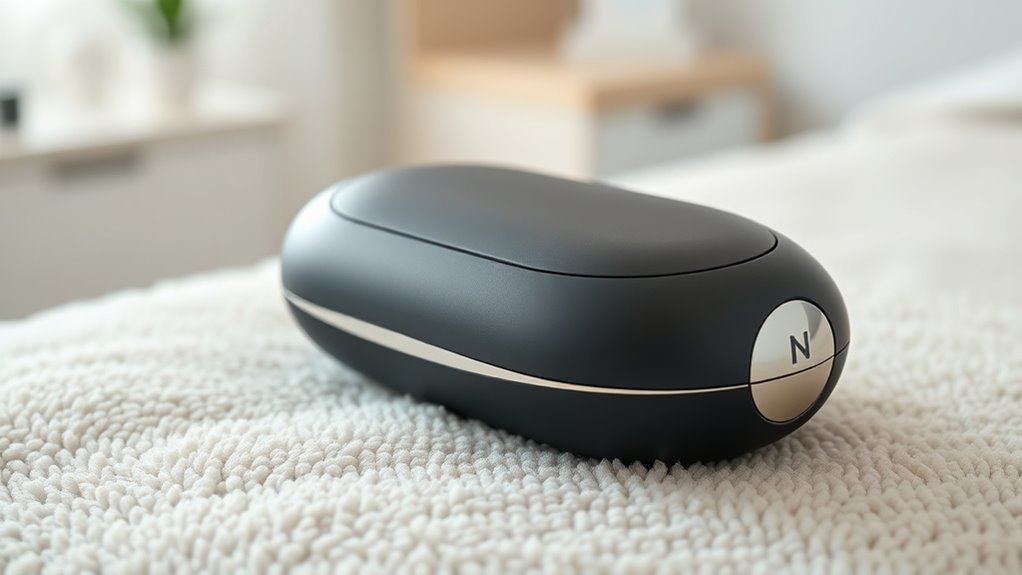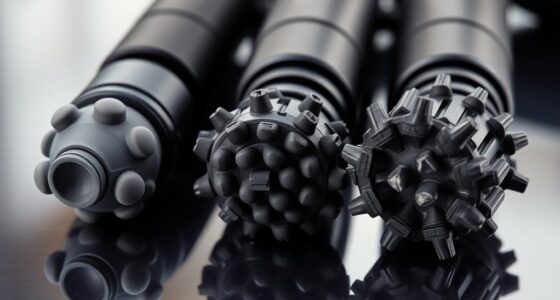Vibration therapy is a non-invasive treatment that uses controlled mechanical vibrations to stimulate your muscles and tissues, making it an effective alternative to percussion therapy. It promotes muscle relaxation, improves circulation, and helps with recovery—all through targeted vibrations. Many devices are simple to use at home and adjustable to fit your needs. Keep exploring to discover how this innovative approach can enhance your overall wellness and comfort.
Key Takeaways
- Vibration therapy uses controlled mechanical vibrations to stimulate muscles and tissues, promoting relaxation and circulation.
- It serves as a non-invasive alternative to percussion therapy, providing targeted muscle relief.
- The therapy enhances blood flow, accelerates healing, and reduces inflammation through tissue stimulation.
- Vibration devices are user-friendly, adjustable, and suitable for at-home use during warm-up or recovery.
- Overall, it supports health and wellness by improving muscle relaxation, circulation, and vitality.

Have you ever wondered how vibrations can promote health and wellness? It’s a fascinating concept that’s gaining attention as an effective alternative to traditional percussion therapy. Vibration therapy involves applying controlled mechanical vibrations to your body, stimulating muscles and tissues in ways that can lead to essential health benefits. When you experience these vibrations, you might notice your muscles relaxing more deeply and your circulation improving, making it a powerful tool for overall well-being.
One of the main advantages of vibration therapy is its ability to promote muscle relaxation. When vibrations are applied, they create tiny, rapid movements in your muscles, which helps reduce tension and stiffness. This effect can be especially helpful if you deal with chronic muscle tightness, soreness, or stress. Instead of relying solely on massage or manual therapy, vibration therapy provides a consistent, targeted approach that can quickly ease tight muscles and promote a sense of relaxation. You might find yourself feeling less tense and more comfortable after a session, making it easier to move freely and engage in your daily activities.
In addition to muscle relaxation, vibration therapy considerably enhances circulation. When vibrations stimulate your muscles and tissues, they encourage blood flow to areas that might be sluggish or restricted. Improved circulation delivers more oxygen and nutrients to your tissues while helping remove metabolic waste products. This process accelerates healing, reduces inflammation, and can even boost your energy levels. If you’re recovering from an injury or experiencing ongoing discomfort, better circulation can make a noticeable difference in your recovery process. Additionally, some sauna heaters are designed to optimize circulation benefits by providing heat that complements vibration therapy, further supporting your wellness goals.
Moreover, vibration therapy is adaptable and easy to incorporate into your routine. Whether used as a gentle warm-up before exercise or as a relaxing cooldown afterward, it’s simple to adjust the intensity to suit your needs. You don’t need complex equipment or extensive training—many devices are user-friendly and designed for at-home use. As you incorporate vibration therapy into your wellness routine, you may notice improvements not only in muscle relaxation and circulation but also in your overall sense of vitality and comfort.
In essence, vibration therapy offers an innovative, non-invasive way to support your health. By stimulating your muscles and tissues with controlled vibrations, you can enjoy relaxation, enhanced circulation, and a quicker recovery process. It’s a versatile approach that complements other treatments and fits seamlessly into your lifestyle. Whether you’re seeking relief from muscle tension or aiming to boost your circulation, vibration therapy presents a practical and effective alternative to percussion methods, helping you maintain your wellness with ease.
Frequently Asked Questions
Can Vibration Therapy Replace Traditional Physical Therapy?
Vibration therapy can complement traditional physical therapy but isn’t a complete replacement. It may enhance treatment efficacy by improving circulation, reducing muscle tension, and promoting recovery. However, depending on your condition, you should consult with your healthcare provider before substituting conventional methods. Combining vibration therapy with standard treatments offers a holistic approach, potentially leading to better outcomes rather than relying solely on one method.
Are There Any Health Risks Associated With Vibration Therapy?
Think of vibration therapy as a gentle breeze, but even breezes can stir up a storm if you’re not careful. You might experience temporary muscle relaxation or improved bone density, but risks include dizziness or discomfort if overused. Always consult your healthcare provider before starting, especially if you have existing conditions. Used properly, vibration therapy offers benefits; misuse can lead to unwanted side effects.
How Long Does a Typical Vibration Therapy Session Last?
A typical vibration therapy session lasts about 15 to 30 minutes, depending on your specific needs and the treatment plan. You might have sessions several times a week initially, then reduce frequency as your condition improves. The session duration is usually tailored by your therapist to maximize benefits while minimizing any discomfort. Consistent therapy frequency helps optimize results, so follow your provider’s recommendations closely.
Is Vibration Therapy Suitable for Children or Pregnant Women?
Vibration therapy can be suitable for children and pregnant women, but you should always consider pediatric safety and pregnancy considerations first. Consult with a healthcare professional to guarantee the therapy is appropriate for the individual’s age and pregnancy stage. When properly supervised and tailored to their needs, vibration therapy can be a safe, non-invasive option that may help improve circulation and reduce discomfort, but always prioritize expert guidance.
What Specific Conditions Can Vibration Therapy Effectively Treat?
Imagine your body’s tissues dancing to a rhythm—vibration therapy targets this dance to treat specific conditions. It effectively aids muscle recovery, helping muscles heal faster after workouts or injuries. Additionally, it boosts bone density by stimulating bone cells, making bones stronger. This therapy is also beneficial for improving circulation, reducing pain, and enhancing flexibility, making it a versatile option for those looking to support overall musculoskeletal health.
Conclusion
So, if you haven’t tried vibration therapy yet, you’re missing out on a game-changing miracle! It’s like giving your body a superhero boost, blasting away soreness, and revealing your true potential. Say goodbye to dull recovery routines and hello to a revolutionary alternative that could transform your health overnight. Don’t wait around—embrace the power of vibrations and experience a life where pain and fatigue are just distant memories! Your body will thank you forever!









